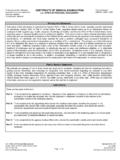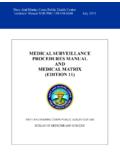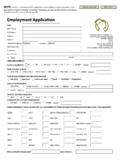Transcription of The medical examination and assessment of …
1 Health and Safety ExecutiveThe medical examination and assessment of commercial divers (MA1)HSE BooksMA1 (rev4) Published 10/15 Contents Introduction 3 Legal aspects 3 Using MA1 4 Role of the AMED 4 medical assessment process 5 Initial medical examination 5 Annual medical examination 6 Return to work medical assessment 6 Second opinion and additional advice 6 Certificate of medical fitness to dive 7 Appeals 7 General medical considerations 8 Gender 8 Age 8 Medication 8 Smoking 8 Disability 8 Infection and impaired immunity 9 Malignancy 9 Obesity 9 Mental health
2 11 Alcohol, drug or substance misuse 12 Respiratory system 12 Asthma 14 The medical examination and assessment of commercial divers (MA1) Page 1 of 27 This document replaces the previous version of MA1 published in December 2011, following a review by the Health and Safety Executive (HSE). In undertaking the review, HSE collaborated with the UK Sports Diving medical Committee and received contributions from invited experts on the following sections of MA1: obesity, mental health, respiratory fitness, cardiovascular fitness, neurological fitness, ENT, diabetes and exercise testing.
3 The document also contains revisions to sections on the gastrointestinal system and haematology, and updates administrative aspects. Cardiovascular system 14 Blood pressure 14 ECG 15 Ischaemic heart disease 15 Dysrhythmia 15 Pacemaker 15 Patent foramen ovale (PFO) 15 Valvular heart disease 16 Peripheral circulation 16 Nervous system 16 Musculoskeletal system 17 Ear, nose and throat 17 Vision 18 Dental health 19 Endocrine system 19 Diabetes 19 Thyroid disease 19 Other disorders 20 Genitourinary system 20 Gastrointestinal system 20 Skin 20 Haematology 21 Exercise testing 21 Safety 21 Testing 21 Interpretation 22 Appendix 1 Summary of routine investigations to perform at initial and annual medical examinations 23 Appendix 2 Cardiac screening tool 24 Acknowledgements 25 References and further information 26 The medical
4 examination and assessment of commercial divers (MA1) Page 2 of 27 Health and Safety ExecutiveIntroduction1 This document contains Health and Safety Executive (HSE) standards and guidelines for the medical examination and assessment of working divers. They are primarily for use by HSE Approved medical Examiners of Divers (AMEDs) in performing fitness to dive medicals for the purposes of the Diving at Work Regulations They are intended to influence professional practise and, as a consequence, enhance the quality and reduce any unnecessary variability of fitness to dive assessments undertaken by HSE AMEDs.
5 In addition, they provide a benchmark against which HSE can audit the performance of AMEDs and consider appeals from divers to review the decisions of AMEDs. 2 The standards and guidelines reflect the need to protect the health, safety and welfare of divers at work. They take account of the mental and physical requirements for meeting reasonably foreseeable underwater emergencies and the physiological effects of working in a hyperbaric aspects3 Diving is a high hazard, high risk activity and there are specific regulations on diving at work to control the risks.
6 The Diving at Work Regulations 1997 (DWR) cover all dives when one or more divers are at work in the diving industry, whether employed or self-employed. They apply to everyone from the client to the diver undertaking work for the client. All persons involved have a responsibility to take measures to safeguard the health and safety of those taking part in the diving project as well as their own. Further information is available on HSE s diving Five Approved Codes of Practice, tailored to the needs of different sectors of the diving industry, accompany DWR.
7 They are: Commercial diving projects offshore;3 Commercial diving projects inland/inshore;4 Recreational diving projects;5 Media diving projects;6 and Scientific and archaeological diving Under DWR, all divers at work must have a valid certificate of medical fitness to dive, issued by an AMED. The certificate is valid for up to 12 months. It needs renewing before it expires if the diver wishes to continue diving at work. 6 It is a legal requirement (Regulation 13(1) of DWR) that an individual must not dive in a diving project if they know of anything, including any illness or medical condition, which makes them unfit to In order to undertake medical examinations and fitness assessments under DWR, a doctor must have a valid Certificate of Approval issued by HSE.
8 This authorises the AMED to conduct medical examinations under the regulations for a stated period. HSE s AMED web pages contain further information on the approval medical examination and assessment of commercial divers (MA1) Page 3 of 27 Health and Safety ExecutiveUsing MA18 Professional divers should be medically and physically fit to undertake their work. The medical examination has two aims. It should enable AMEDs to identify those medical conditions that might exclude an individual from commercial diving (either permanently or temporarily) or require further specialist assessment .
9 It should also assess the functional capacity of the diver to undertake their work safely. Applying the standards and guidelines set out in this document will help achieve these aims and promote a consistent approach to fitness assessments. They are based on scientific evidence and expert opinion and are subject to periodic review. 9 MA1 specifies medical conditions that are an absolute contraindication to diving or require further specialist assessment and those where a diver may be considered fit to dive or fit to dive with restrictions.
10 It does not cover all conditions that divers may present with or that may be identified at their medical . In such cases, AMEDs should obtain additional advice as required. 10 If there is doubt about an individual s fitness to dive, AMEDs should seek specialist advice where appropriate and adopt a risk-based approach in each case. The risk assessment should consider any specialist advice obtained, relevant history and examination findings, test results, and the type of diving and working conditions. Performing a risk assessment supported by the standards and guidelines in this document allows AMEDs to use discretion in making a justifiable, informed judgement on fitness to dive.

















